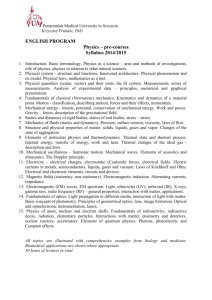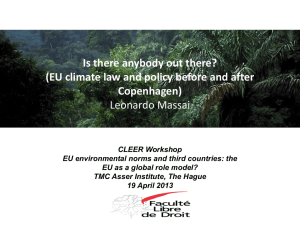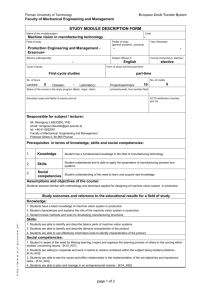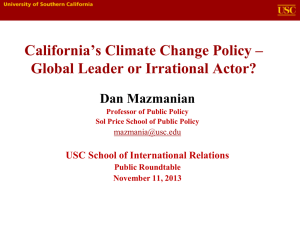Pew Post-Poznan Summary and Outcomes
advertisement
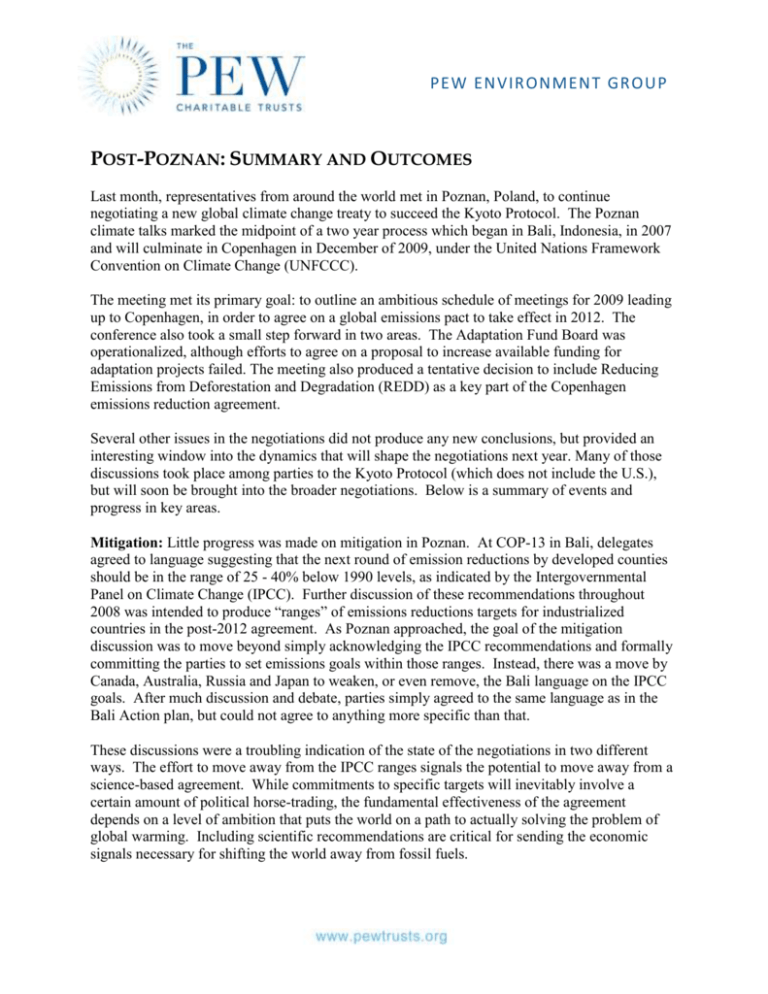
PEW ENVIRONMENT GROUP POST-POZNAN: SUMMARY AND OUTCOMES Last month, representatives from around the world met in Poznan, Poland, to continue negotiating a new global climate change treaty to succeed the Kyoto Protocol. The Poznan climate talks marked the midpoint of a two year process which began in Bali, Indonesia, in 2007 and will culminate in Copenhagen in December of 2009, under the United Nations Framework Convention on Climate Change (UNFCCC). The meeting met its primary goal: to outline an ambitious schedule of meetings for 2009 leading up to Copenhagen, in order to agree on a global emissions pact to take effect in 2012. The conference also took a small step forward in two areas. The Adaptation Fund Board was operationalized, although efforts to agree on a proposal to increase available funding for adaptation projects failed. The meeting also produced a tentative decision to include Reducing Emissions from Deforestation and Degradation (REDD) as a key part of the Copenhagen emissions reduction agreement. Several other issues in the negotiations did not produce any new conclusions, but provided an interesting window into the dynamics that will shape the negotiations next year. Many of those discussions took place among parties to the Kyoto Protocol (which does not include the U.S.), but will soon be brought into the broader negotiations. Below is a summary of events and progress in key areas. Mitigation: Little progress was made on mitigation in Poznan. At COP-13 in Bali, delegates agreed to language suggesting that the next round of emission reductions by developed counties should be in the range of 25 - 40% below 1990 levels, as indicated by the Intergovernmental Panel on Climate Change (IPCC). Further discussion of these recommendations throughout 2008 was intended to produce “ranges” of emissions reductions targets for industrialized countries in the post-2012 agreement. As Poznan approached, the goal of the mitigation discussion was to move beyond simply acknowledging the IPCC recommendations and formally committing the parties to set emissions goals within those ranges. Instead, there was a move by Canada, Australia, Russia and Japan to weaken, or even remove, the Bali language on the IPCC goals. After much discussion and debate, parties simply agreed to the same language as in the Bali Action plan, but could not agree to anything more specific than that. These discussions were a troubling indication of the state of the negotiations in two different ways. The effort to move away from the IPCC ranges signals the potential to move away from a science-based agreement. While commitments to specific targets will inevitably involve a certain amount of political horse-trading, the fundamental effectiveness of the agreement depends on a level of ambition that puts the world on a path to actually solving the problem of global warming. Including scientific recommendations are critical for sending the economic signals necessary for shifting the world away from fossil fuels. PEW ENVIRONMENT GROUP The failure of the Kyoto Protocol parties to move this discussion further also indicates that they are waiting for the talks under the UN Framework Convention, which includes the U.S., to proceed before any real discussion of mitigation targets is had – affirming how important the U.S. emissions reduction commitment will be to setting overall emissions goals for the treaty. Adaptation: After much debate, parties agreed to legalize the Adaptation Fund Board, giving it authority to identify projects and to allocate money towards them. This was one of the most significant outcomes of Poznan, and a major victory for those countries most vulnerable to the impacts of climate change. Currently, the Adaptation Fund is financed by setting aside a 2% levy of the revenues from the Clean Development Mechanism, which produces only a fraction of the amount needed. In Poznan, a decision on a mechanism to increase adaptation funding was not agreed on, although discussions on using a portion of the proceeds from the carbon market to support the adaptation fund gained support by developing countries. Overall, these discussions under adaptation previewed some interesting concepts for the overall financing discussion that is likely to be a key component of the Copenhagen agreement. Carbon Capture and Storage in the Clean Development Mechanism: The idea that CCS projects should be included in the CDM has been part of the discussion of CDM reform for quite some time. In Poznan, a new champion for this cause surfaced. Saudi Arabia tied up the final decisions from the Kyoto parties over this issue for several days of negotiation. The proposal to allow CDM funding to be used for CCS development was opposed by many developing countries that feared the high cost of the projects could drain precious resources from the CDM. Other developing countries argued that CDM funding should not be allocated due to a fundamental concern over unproven technology. This debate shed some light on the emerging role of Saudi Arabia in the upcoming negotiations, who also engaged in an aggressive strategy to seek compensation for lost oil revenues as the world moves away from fossil fuels. It became clear that the Saudi Arabian delegates were prepared to block negotiations over specific issues that it views as in its national interest. An agreement on this issue could not be reached in working groups and discussions were ultimately tabled for the March Bonn meetings. Reducing Emissions from Deforestation and Degradation (REDD): This past year, the negotiations on how REDD will fit into a new agreement have centered on whether the incentives for emission reductions will come in the form of carbon credits or direct financial assistance and whether or not sub-national projects will qualify. These looming issues were not resolved in Poznan, but importantly, parties agreed that REDD will be a component of a post2012 framework. Instead, the most controversial issues in Poznan surrounded how the text treated indigenous peoples and biodiversity; two areas that most environmental and human rights groups felt were not given adequate weight to. The lack of guidelines for biodiversity and indigenous rights protection in the current agreement is likely to slow negotiations over REDD over the next year. PEW ENVIRONMENT GROUP Technology Transfer: In November of 2008, the Expert Group on Technology Transfer (EGTT) produced a series of draft papers addressing the issue of Technology Transfer. The drafts focused mainly on performance indicators, finance and a long-term strategy to facilitate the development, deployment, diffusion and transfer of technologies. In Poznan the reports were seen as taking steps in the right direction and most working groups were constructive. Progress was made on furthering the interim reports and it seemed as if many parties have begun to view technology transfer is an issue critical to the negotiations. The EGTT Chair will release his final draft in June of 2009. While some progress was made in technology transfer, many issues still need to be addressed before the Copenhagen agreement: A fast-track system for transferring the most essential technologies to the places in greatest need still exists. Technology Action Programs that highlight individual technologies and move them through this process could complete this task. The difficulty of resolving the role of intellectual property rights is a matter of opinion. Many observers now believe that IPR can be dealt with fairly easily on a case-by-case basis and can be addressed on the political level when needed. A mechanism to enable least developed and developing countries to acquire, absorb and implement new technologies in specific locations has been pushed by India and backed by most parties, but has yet to be developed. Finance: As mentioned earlier, important progress was made in terms of finance in the Adaptation Fund. However, little progress was made regarding finance in the broader negotiations. The proposal from the Group of 77 and China (G77) and the Norway Proposal were the new items on the table heading into Poznan. The Norway Proposal, which would utilize the global carbon market by withholding a portion of permits from national allocations to auction and generate revenue for specific needs, received general supported by developed countries and was even supported by Ivo de Boer in high-level sessions. The proposal by the G77 and China, which established guiding principles that would help bring funding and technology to the developing world was met with much less support by the majority of developed countries. In fact, it took nearly a week for the first developed country (the EU) to even acknowledge that a proposal had been submitted on this topic claiming they had no mandate to engage in finance and that their hands were tied because of the EU climate and energy package. In working group negotiations, developed countries generally expressed their satisfaction with the Global Environment Facility’s (GEF) performance, while developing countries had numerous concerns. Discussions surrounding the Share of Proceeds issue, which determines how adaptation funding should be distributed, heated up, but came to no formal conclusions. PEW ENVIRONMENT GROUP In the coming year, contentious financial issue will likely be: The division between developed countries who would like to see an existing mechanism manage finances while the developing countries are pressing for a new mechanism governed and controlled by the COP. Developing countries would also like to see funds raised through the public sector while developed countries believe they should largely be raised through the private sector. In Poznan, there was much support generated for combining Norway’s proposal with a separate proposal on finance submitted by Mexico in June of 2008. Mexico’s proposal would create a “World Climate Change Fund” operated by an executive council within the UNFCCC and derives funding for mitigation, adaptation and technology transfer through country-specific contributions. Parties would contribute in strict accordance to the principal of common but differentiated responsibilities and specific amounts would be based on indicators such as greenhouse gas emissions or GDP. Linking the plan to a levy on existing carbon markets (Norwegian Plan) could have the potential to raise adequate finances to meet with the objectives of the convention.
